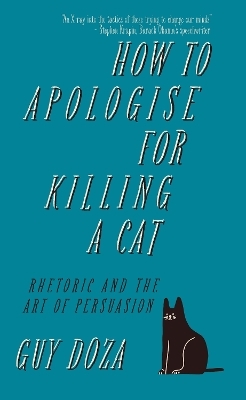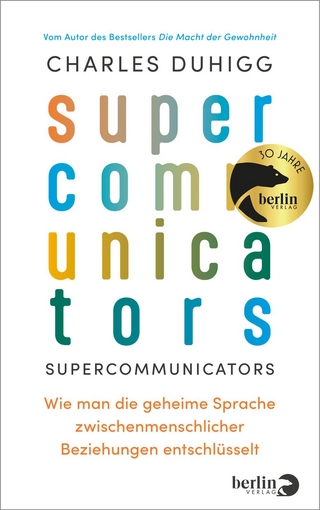
How to Apologise for Killing a Cat
Canbury Press (Verlag)
978-1-912454-70-9 (ISBN)
‘Most books on persuasion teach the few how to sway the many. With wit and vim, Guy has given us something else: an X-ray into the tactics of those trying to change our minds and behaviour.’ - Stephen Krupin, former speechwriter for Barack Obama
When Winston Churchill spoke in Parliament, he convinced an empire to go to war. When Martin Luther King spoke in Washington, he convinced millions to open their hearts to change. When Oprah Winfrey said: ‘Do what you have to do until you can do what you want to do,’ she also used rhetoric. As we have here, by deploying the rule of three to stress a point.
Rhetoric - the art of persuasive speaking and writing – often gets a bad rap. In this dazzling, fast-paced guide, speechwriter Guy Doza rescues rhetoric from the shadows and showcases its immense power to change lives, for good and bad.
Highlighting punchy sayings from Ancient Rome to modern marketing, he shows how leaders, businesses and even our own friends use rhetorical techniques every day to make convincing arguments.
What’s more, this guide to rhetoric will show you how to learn to use this persuasive language in your own life:
How to convince an investor to back your venture
What to say to a potential lover in a bar
And, the six rules of apology you should use if you ever accidentally run over the next-door neighbour’s cat...
How to Apologise for Killing a Cat is a quick read, humorous and highly practicable. It decodes the tricks and techniques of rhetoric for everyday readers.
It's the only book you need to make a convincing marketing pitch.
It's the only book you need to give a rousing speech.
It's the only book you need to write persuasively.
It's the best book to explain the technique we've just used here. After reading this book, you will start to see the trick of rhetoric used everywhere.
After reading this book, you will never see the world the same way again!
About the author
Guy Doza is a speechwriter and trainer. He has a Master’s degree in Rhetoric from the University of London and uses rhetoric in the speeches he writes for senior politicians and business leaders. He trains government speechwriters in logic and rhetoric.
Introduction
Have you ever had that unpleasant anxiety of taking your car to the mechanic and feeling like you’re being swindled? Most of you will probably know exactly what I am talking about. We don’t know how cars work, we don’t know what the parts are called and we don’t know how to fix them ourselves. This lack of knowledge makes us vulnerable and susceptible to exploitation, and we know it. So does the mechanic.
Now, most mechanics are honest individuals, not rogues, but can we say the same of people who run countries and big companies? When it comes to ordinary life away from the car engine or central heating boiler, most of us don’t even realise just how vulnerable we are. People can use persuasive language to swindle us, cheat us, and exploit us to the hilt. And the worst part is that we are not even aware that it is happening.
Welcome to rhetoric, the art of persuasion. Rhetoric is a superpower. It can alter the way we think, the way we behave and sometimes even the way we live our lives. And its most explosive charge lies in its subtlety. We need to be aware of how such persuasive language is used, not only so that we can be more persuasive ourselves, but defend ourselves against the rhetorical advances of those who would seek to exploit us.
A Dark Art?
For too long, rhetoric has been a dark and ancient art confined to the secretive circles of politics and academia. This mystery and misunderstanding has often led to the public to consider it to be the tool of crooks, spin doctors and villains. But no more! The time has come to bring rhetoric out of the darkness and show it for what it is: a mighty linguistic tool. Whether it is a conversation between friends in a café, a pathetic attempt to flirt at a bar, or a meaningful conversation with a world renowned philosopher, rhetoric is everywhere. It is how we invoke authenticity, how we convey meaning, and how we convince.
So as well as looking at the grand speeches of eloquent orators and established speakers, this book will delve into the street rhetoric that we encounter in our everyday lives. Whether it’s a cheap use of ethos or a dodgy use of occultatio, rhetoric is thriving in our offices, dwelling in our pubs and lurking in our very homes. We are going to look at some of the forms that rhetoric can take as it attempts to twist our thoughts and muddy our reasoning.
Sadly, reading this book will not turn you into an eloquent millionaire who is able to close billion dollar business deals, perform Jedi mind tricks, and convince anyone of anything. There are plenty of gimmicky books out there if that is what you are looking for. Rather, this book is designed to help you become more aware of the role that rhetoric plays in the world around us: the good, the bad and the ugly. And, with a certain amount of caution, you will be more prepared to use it yourself while simultaneously being conscious of how it might be used against you, whether for morality, for manipulation, money, or malice.
Buy the book and carry on reading!
Guy Doza is a speechwriter, trainer, and public affairs consultant. He started his career in political research before branching out into corporate speechwriting. He now works independently for a range of international clients whom he writes on a variety of subjects. Guy is a two time TEDx speaker and has lectured on rhetoric at several of the world's leading universities. After his excellent experience writing his debut book with Canbury press (his words), he has written a second: The Language of Evil: How Dictators Manipulate the Masses and Wield Power Through Words (2025).
INTRODUCTION. The author introduces the ancient art of rhetoric, and explains its importance in everyday life as well as how it has been used – and still is used – by people and organisations seeking to influence our views and behaviour. Mentions rhetoric, swindling, persuasive language, Aristotle
1. TOUCHING THE HEART. Introducing how rhetoric can be used in practice, with examples ranging from a simple love letter phrased in many different ways to convey different messages to the Axis of Evil speech by US President George W Bush and the Stolen Generations speech by Australian PM Kevin Rudd
2. THE THREE MUSKETEERS OF RHETORIC. Welcome to Logos, Ethos, and Pathos, key elements of rhetoric – a bit like the rhetorical equivalent of the four horsemen of the apocalypse. Only with three, so the three musketeers is a better cliché. Logos is the use of logic, ethos is the use of emotion
3. LOGOS. Introducing and explaining the uses of logos in rhetoric, including a quick primer on formal logic such as minor and major premise and logical fallacies. Mentions rhetorical technique, formal logic, informal logic, Malala, MMR vaccine, Brexit Battle Bus, Barack Obama, argumentum ad rem
4. ETHOS. Introducing and explaining the rhetorical concept of ethos – the use of reputation to bolster one's argument. Mentions argumentum ad hominem, JK Rowling, Julia Gillard, Justin Bieber, George W Bush, Shakespeare, All’s Well That Ends Well
5. PATHOS. Introduction to pathos in rhetoric, looking at examples throughout history where speakers or writers have invoked emotion to strengthen their argument. Donald Trump, Martin Luther King Jr, I Have a Dream speech, Michelle Obama, Melania Trump, Johnny Mercer, Hilary Benn, Oprah Winfrey
6. REPETITION. The use of the many different types of repetition in rhetoric, including tricolon, epizeuxis, anaphora, epistrophe, anadiplosis, abundantia, isocolon, chiasmus. Mentions historical and political figures Julius Caesar, Abraham Lincoln, Tony Blair, Barack Obama and Kevin Rudd
7. REPETITION (AGAIN!). Explaining further rhetorical techniques such as anadiplosis, abundantia, isocolon, chiasmus. Mentions We Shall Fight on the Beaches, Yoda, US President George W Bush, Malcolm X, abundantia, Kevin Rudd, Sojourner Truth, Ain’t I a woman? anti-slavery speech
8. TRICKS OF THE TIRADE. Introducing other rhetorical techniques used by the likes of Nelson Mandela and Donald Trump. Mentions rhetoric, comprobatio, Donald Trump, Mississippi, Alabama, Nelson Mandela, occultatio, kairos, periphrasis, aporia, apostrophe, apodioxis, digressio, reductio ad absurdum
9. LOGICAL FALLACIES. Revealing the logical fallacies present when skilled practitioners of rhetoric use persuasive language and writing. Mentions slippery slope, Australian Marriage Law Postal Survey, Benjamin Netanyahu, tu quoque, false cause, David Silvester, false dichotomy, Abdul Fattah al-Sisi
10. TO QUESTION OR NOT TO QUESTION – THAT IS THE QUESTION. Exploring the operation of rhetorical questions, known in rhetoric as erotema. Examples include Greta Thunberg, Barack Obama and Shylock in Merchant of Venice. Mentions false dichotomy, epiplexis, Merchant of Venice, Shylock, Hypophora
11. I'M SORRY I DID IT... APOLOGIES. How to apologise, without making matters worse, for instance if you run over the next-door neighbours cat, don't glibly offer to buy them a new one. Features the six key psychological components of a successful apology. Mentions admission of guilt and regret
12. RHETORIC IN TIMES OF CRISIS. The use of rhetoric in crises, as demonstrated by Winston Churchill. We Shall Fight Them on the Beaches, kairos, People’s Republic of China, Mao Zedong, Covid-19 speech, anadiplosis, tricolon, Queen Elizabeth II, Princess Diana funeral rhetoric, Menachem Begin, BP spill
13. RHETORIC IN THE WORKPLACE. Rhetoric in LinkedIn profiles, job applications and CVs. Mentions ethos, work rhetoric, employment rhetoric, office banter, antithesis, job applications, Legally Blonde, comprobatio, CV rhetoric, TEDx Talk, rhetoric public speaking
14. RHETORIC AND PUBS (PUBS, TINDER AND THE GUTTER). The operation of rhetoric in private lives, such as in dating profiles and in wedding vows. Mentions tricolon, epizeuxis, 'education, education, education', rhetoric of Tinder, rhetorician, Grindr profile, Pride and Prejudice, Jane Austen
15. THE END AND A QUIZ. A quiz to end the book. See how many rhetorical techniques you can spot in Barack Obama's acceptance speech after the 2008 presidential election in Grant Park, Chicago. Techniques to spot: kairos, anaphora, epistrophe, tricolon, antithesis, erotema, ethos, pathos, isocolon
GLOSSARY. Glossary of rhetorical terms. Mentions ethos, pathos, logos, abundantia, anadiplosis, anaphora, antithesis, apodioxis, aporia, apostrophe, argumentum ad hominem, argumentum ad populum, argumentum ad rem, chiasmus, comprobatio, digressio, elenchus, enthymeme, epiplexis, epistrophe
ACKNOWLEDGEMENTS. Mentions CMM Literary Agency, Simon & Schuster, Kate Woodruff, Anna Stelter, Ruby Bennett, Canbury Press
INDEX. Full index of rhetorical terms and historical characters used in the book, ranging from Tony Abbot, the Australian PM to Mao Zedong
| Erscheinungsdatum | 02.09.2022 |
|---|---|
| Zusatzinfo | 17 black and white illustrations; 3 diagrams; 1 iondex; 1 glossary |
| Sprache | englisch |
| Maße | 135 x 216 mm |
| Gewicht | 400 g |
| Themenwelt | Literatur ► Comic / Humor / Manga |
| Sachbuch/Ratgeber ► Beruf / Finanzen / Recht / Wirtschaft ► Briefe / Präsentation / Rhetorik | |
| Schulbuch / Wörterbuch ► Lexikon / Chroniken | |
| Schulbuch / Wörterbuch ► Wörterbuch / Fremdsprachen | |
| Sonstiges ► Geschenkbücher | |
| ISBN-10 | 1-912454-70-X / 191245470X |
| ISBN-13 | 978-1-912454-70-9 / 9781912454709 |
| Zustand | Neuware |
| Haben Sie eine Frage zum Produkt? |
aus dem Bereich


